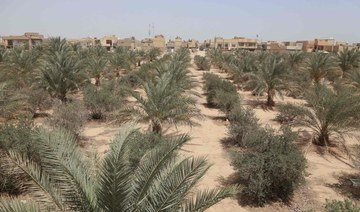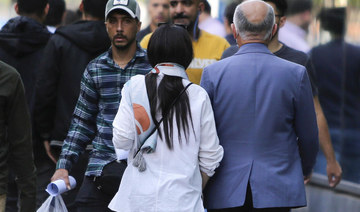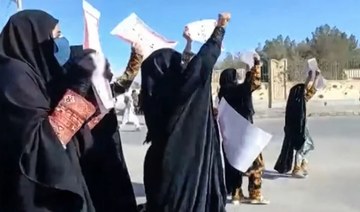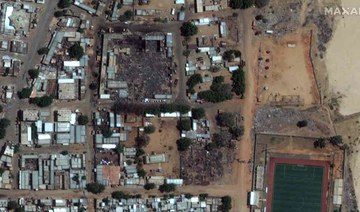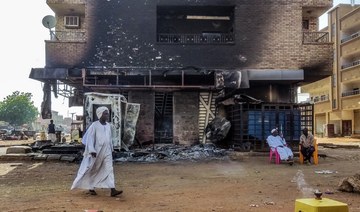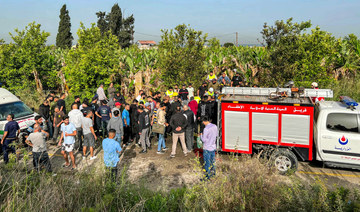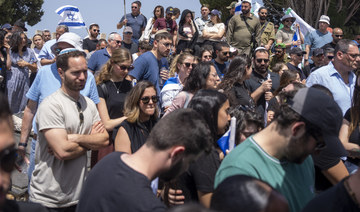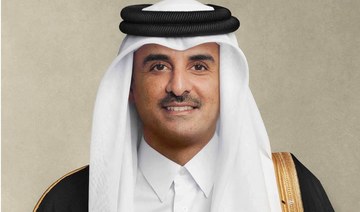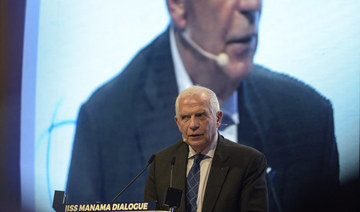SABHA, Jordan: Efforts to restore damaged but once fertile land in Jordan’s desert are sprouting hope for one of the world’s most water-scarce nations, as a land assessment report Wednesday warned of the growing scale of global degradation.
Local organizations believe projects that reintroduce native plants and implement smart water harvesting systems will cushion the impacts of climate change and desertification, which are only set to worsen, according to the United Nations report.
The UN desertification agency says 40 percent of land globally is currently degraded, blaming unsustainable land and water management, poor agricultural practices, mining, urbanization and infrastructure development for the land’s deterioration.
Mira Haddad, from the International Center for Agricultural Research in the Dry Areas said several other factors, including “overexploitation of vegetation cover, overgrazing, and...new land practices” as well as climate change are also contributing to land degradation in Jordan.
But environmentalists are already pursuing options to ward off further damage. One of the efforts, run by the Watershed and Development Initiative, is introducing four native plants to 10,000 acres (41 square kilometers) of desert in the Sabha reserve, roughly 56 miles (90 kilometers) east of the Jordanian capital Amman.
“We’re working on the water, we’re working on the green cover and we’re working also with the habitats of the creatures, from insects to animals and all living parts of that ecosystem,” Deyala Tarawneh, a WADI founding member, said. “The success rate of these plants is 85 percent, which is considered a very high percentage, and they only need to be watered once, which is also reducing the amount of water needed for the irrigation of the green areas.”
But despite the success of WADI’s planting initiative, land restoration in Jordan is still facing several challenges: the number of land unit areas available for restoration is lacking, and the willingness of local communities to leave the land for at least one or two rainy seasons without grazing is also hindering efforts, said ICARDA’s Haddad.
Jordan is one of several countries already grappling with the effects of degradation, with more than 2.3 billion people currently living in water-stressed countries, according to the UN report. It warned that more food supply disruptions, forced migration and greater pressure on species survival are also expected as climate change intensifies and poor land management practices continue. By 2030, it warns that 700 million people could be displaced by drought.
“The situation we have right now is unhealthy and certainly not acceptable,” Ibrahim Thiaw, the executive secretary of the UN desertification agency, told the Associated Press. “The more you degrade land the more you emit carbon and the more you contribute to climate change.”
The report calls for financial support to bolster conservation and restoration in developing countries. It says the expansion of protected areas and conservation hotspots, better water management, smart agriculture, and the rewilding of biodiversity can be boosted by appropriate funding.
If these kinds of measures are implemented on a wider scale, the UN agency’s restoration scenario predicts reduced biodiversity loss and improved soil health, with the benefits particularly felt in North and Sub-Saharan Africa, the Middle East, and Latin America.
But it also notes that inaction would lead to 16 million square kilometers (6 million square miles) — nearly the size of the entire South American continent — of land degradation by 2050.
The report also recommends scaling up land rights for Indigenous peoples and local communities, urging farmers to draw on ample lessons about land restoration, crop adaptation and livestock from established customs and traditional knowledge.
“We welcome new allies to this battle, including economic actors who are increasingly interested in avoiding climate risk, but we must make clear that we will not be used for greenwashing,” José Gregorio Diaz Mirabal, the leader of the Congress of Indigenous Organizations of the Amazon Basin, said in a statement. “Partnering with Indigenous peoples requires embracing transformative change.”
The UN’s Thiaw agreed that support for restoration projects should be ramped up.
“The message from the report is that do not take land degradation as a fatality. It can be addressed, and it is the cheapest solution to the climate crisis and biodiversity loss. It is possible to do it by 2050, which is just one generation,” Thiaw said. “It does not require high tech nor a PhD to undertake. Land restoration is accessible and democratic.”
Several countries, like Jordan, are already addressing their own land issues, from drought preparedness programs in Mexico, the USA and Brazil, to the 11-country Great Green Wall in Africa aimed at restoring 100 million hectares (390,000 square miles) of degraded landscapes along the Sahel.
“Land restoration is a win for the environment, economy, society, and for biodiversity,” said Thiaw. “What we are calling for now is the acceleration of such programs.”
Jordan’s restoration efforts push back on degrading land
https://arab.news/p4pzn
Jordan’s restoration efforts push back on degrading land
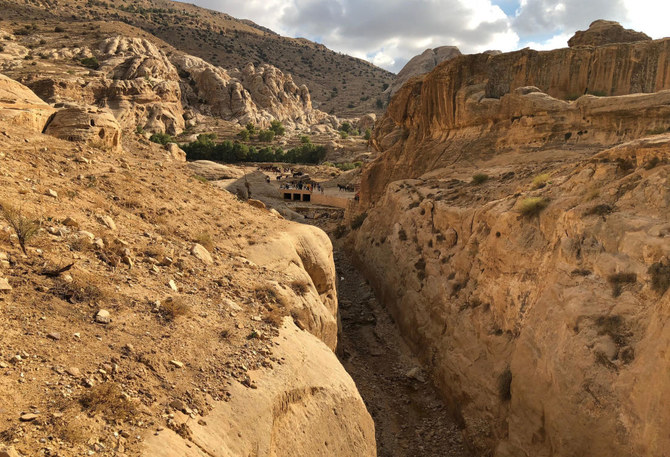
- Local organizations believe projects that reintroduce native plants and implement smart water harvesting systems will cushion the impacts of climate change and desertification
- The UN desertification agency says 40% of land globally is currently degraded
Gaza baby rescued from dead mother’s womb dies
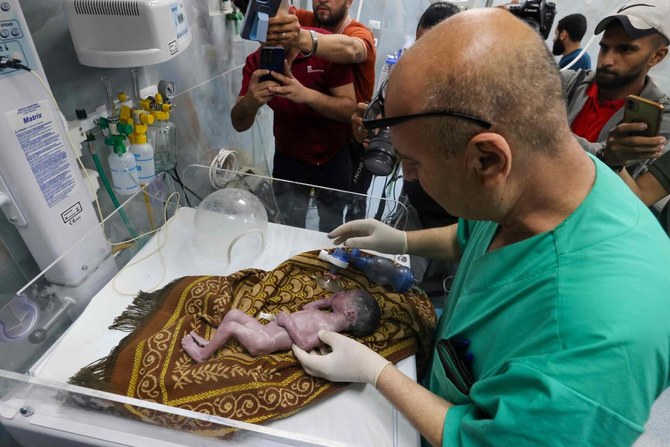
The baby suffered respiratory problems and a weak immune system, said Doctor Mohammad Salama who had been caring for Sabreen Al-Rouh
RAFAH, Gaza Strip: A baby girl who was delivered from her dying mother’s womb in a Gaza hospital following an Israeli airstrike has herself died after just a few days of life, the doctor who was caring for her said on Friday.
The baby had been named Sabreen Al-Rouh. The second name means “soul” in Arabic.
Her mother, Sabreen Al-Sakani (al-Sheikh), was seriously injured when the Israeli strike hit the family home in Rafah, the southernmost city in the besieged Gaza Strip, on Saturday night.
Her husband Shukri and their three-year-old daughter Malak were killed.
Sabreen Al-Rouh, who was 30-weeks pregnant, was rushed to the Emirati hospital in Rafah. She died of her wounds, but doctors were able to save the baby, delivering her by Caesarean section.
However, the baby suffered respiratory problems and a weak immune system, said Doctor Mohammad Salama, head of the emergency neo-natal unit at Emirati Hospital, who had been caring for Sabreen Al-Rouh.
She died on Thursday and her tiny body was buried in a sandy graveyard in Rafah.
“I and other doctors tried to save her, but she died. For me personally, it was a very difficult and painful day,” he told Reuters by phone.
“She was born while her respiratory system wasn’t mature, and her immune system was very weak and that is what led to her death. She joined her family as a martyr,” Salama said.
More than 34,000 Palestinians, many of them women and children, have been killed in the six-month-old war in Gaza between Israel and Hamas militants, according to the Gaza health ministry. Israel denies deliberately targeting civilians in its campaign to eradicate Hamas.
Much of Gaza has been laid to waste by Israeli bombardments and most of the enclave’s hospitals have been badly damaged, while those still operating are short of electricity, medicine sterilization equipment and other supplies.
“(Sabreen Al-Rouh’s) grandmother urged me and the doctors to take care of her because she would be someone that would keep the memory of her mother, father and sister alive, but it was God’s will that she died,” Salama said.
Her uncle, Rami Al-Sheikh Jouda, sat by her grave on Friday lamenting the loss of the infant and the others in the family.
He said he had visited the hospital every day to check on Sabreen Al-Rouh’s health. Doctors told him she had a respiratory problem but he did not think it was bad until he got a call from the hospital telling him the baby had died.
“Rouh is gone, my brother, his wife and daughter are gone, his brother-in-law and the house that used to bring us together are gone,” he told Reuters.
“We are left with no memories of my brother, his daughter, or his wife. Everything was gone, even their pictures, their mobile phones, we couldn’t find them,” the uncle said.
UN denounces ‘more serious’ Iran crackdown on women without veils
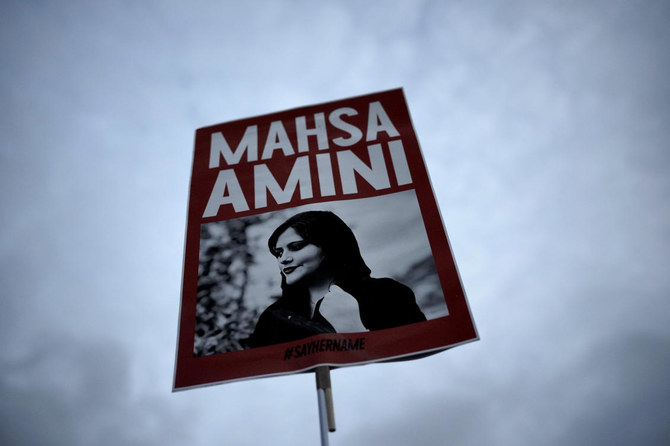
- Hundreds of businesses including restaurants and cafes have been shut down for not enforcing the hijab rule
- More women began refusing the veil in the wake of the 2022 death in custody of 22-year-old Mahsa Amini
GENEVA: The United Nations said Friday that it was concerned by reports of new efforts to track and punish Iranian women, some as young as 15, who refuse to wear the headscarf required under the country’s Islamic law.
The UN Human Rights Office also expressed alarm about a draft bill on “Supporting the Family by Promoting the Culture of Chastity and Hijab,” which would impose tougher sentences on women appearing in public without the hijab.
“What we have seen, what we’re hearing is, in the past months, that the authorities, whether they be plainclothes police or policemen in uniform, are increasingly enforcing the hijab bill,” Jeremy Laurence, a spokesman for the office, said at a press conference.
“There have been reports of widespread arrests and harassment of women and girls — many between the ages of 15 and 17,” he said.
Iranian police announced in mid-April reinforced checks on hijab use, saying the law was increasingly being flouted.
Hundreds of businesses including restaurants and cafes have been shut down for not enforcing the hijab rule, and surveillance cameras are being used to identify women without it, Laurence said.
More women began refusing the veil in the wake of the 2022 death in custody of 22-year-old Mahsa Amini after her arrest by Iran’s morality police for allegedly breaking the headscarf law, which sparked a wave of deadly protests against the government.
Laurence said that on April 21, “the Tehran head of the Islamic Revolutionary Guard Corps announced the creation of a new body to enforce existing mandatory hijab laws, adding that guard members have been trained to do so ‘in a more serious manner’ in public spaces.”
And while the latest draft of the new hijab bill has not been released, “an earlier version stipulates that those found guilty of violating the mandatory dress code could face up to 10 years’ imprisonment, flogging, and fines,” he said, adding that “this bill must be shelved.”
The Human Rights Office also called for the release of a rapper sentenced to death for supporting nationwide protests sparked by Amini’s death.
Toomaj Salehi, 33, was arrested in October 2022 for publicly backing the uprising.
“All individuals imprisoned for exercising their freedom of opinion and expression, including artistic expression, must be released,” Laurence said.
UN seeks to deescalate Sudan tensions amid reports of possible attack
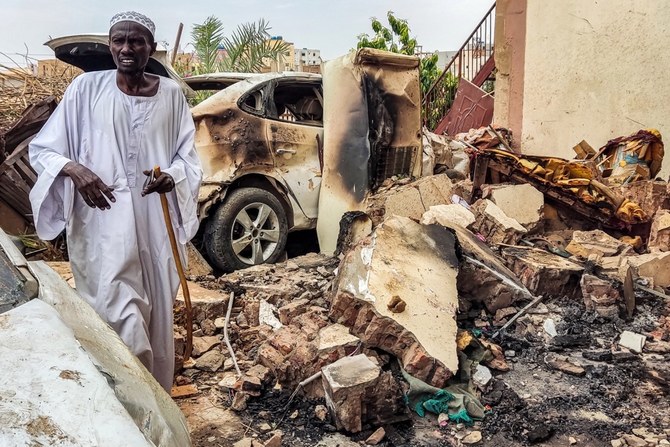
- UN Secretary-General Antonio Guterres’ envoy is engaging with all parties to deescalate tensions
UNITED NATIONS: The United Nations is increasingly concerned about escalating tensions in Al-Fashir in Sudan’s North Dafur region amid reports that the Rapid Support Forces are encircling the city, signaling a possible imminent attack, the UN’s spokesperson said on Friday.
UN Secretary-General Antonio Guterres’ envoy is engaging with all parties to deescalate tensions in the area, the spokesperson said.
Israeli army says missile fire kills civilian near Lebanon
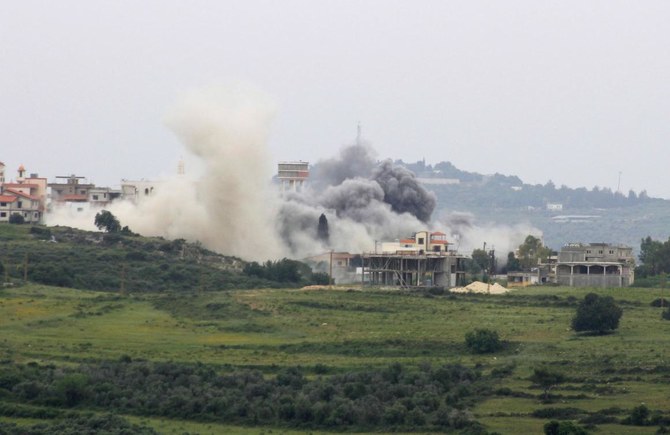
- The violence has fueled fears of all-out conflict between Iran-backed Hezbollah and Israel
- “Overnight, terrorists fired anti-tank missiles toward the area of Har Dov in northern Israel,” the Israeli army said
JERUSALEM: The Israeli army said Friday a civilian was killed near the country’s northern border with Lebanon, as near-daily exchanges of fire with Hezbollah rage.
Both sides have stepped up attacks this week, with Hezbollah increasing rocket fire and Israel saying it had carried out “offensive action” across southern Lebanon.
The violence has fueled fears of all-out conflict between Iran-backed Hezbollah and Israel, which last went to war in 2006.
“Overnight, terrorists fired anti-tank missiles toward the area of Har Dov in northern Israel,” the Israeli army said, referring to the disputed Shebaa Farms district.
“As a result, an Israeli civilian doing infrastructure work was injured and he was later pronounced dead.”
Israeli media reported that the victim was an Arab-Israeli truck driver. Police told AFP they had not identified the body, but said it was the only one found after a truck was hit.
Hezbollah said it had destroyed two Israeli vehicles in the Kfarshuba hills overnight in a “complex ambush” on a convoy using missiles and artillery.
The Israeli army did not comment directly on the claim.
It said Israeli fighter jets struck Hezbollah targets around Shebaa village in southern Lebanon including a weapons store and a launcher, while soldiers “fired to remove a threat in the area.”
It said fighter jets also “struck Hezbollah operational infrastructure in the area of Kfarshuba and a military compound in the area of Ain El Tineh in southern Lebanon.”
Lebanon’s official National News Agency reported that Shebaa village, Kfarshuba and Helta were targeted by “more than 150 Israeli shells,” leaving homes damaged.
Iran-backed Hezbollah has been trading almost-daily fire with the Israeli army since the day after its Palestinian ally Hamas carried out an unprecedented attack on Israel on October 7.
Since October 8 at least 380 people have been killed in Lebanon, including 252 Hezbollah fighters and dozens of civilians, according to an AFP tally.
Israel says 11 soldiers and nine civilians have been killed on its side of the border.
Tens of thousands of people have been displaced on both sides.
EU commits $73 million more for Gaza aid
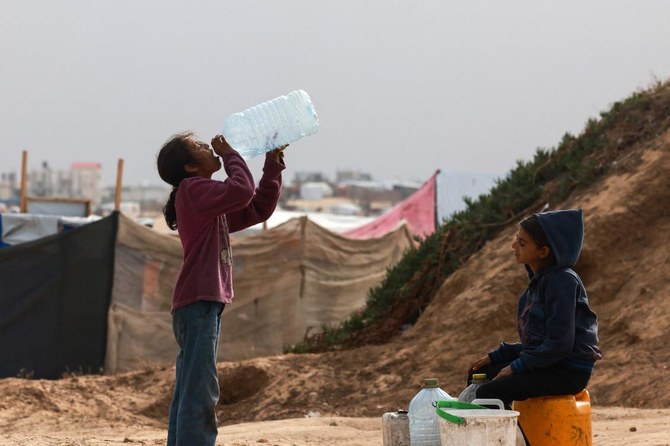
- New EU aid would be focused on food deliveries, clean water, sanitation and shelters
- The EU and United States have demanded that Israel allows more aid into Gaza
BRUSSELS: The European Union on Friday said it was giving an extra 68 million euros ($73 million) to provide desperately needed aid to Palestinians in Gaza.
The territory has been devastated by more than six months of Israeli bombardment and ground operations after Hamas’s October 7 attack, leaving the civilian population of two million people in need of humanitarian assistance to survive.
“In light of the continued deterioration of the severe humanitarian crisis in Gaza, and the steady rise of needs on the ground, the (European) Commission is stepping up its funding to support Palestinians affected by the ongoing war,” an EU statement said.
“This support brings total EU humanitarian assistance to 193 million euros for Palestinians in need inside Gaza and across the region in 2024.”
The EU said the new aid would be focused on food deliveries, clean water, sanitation and shelters, and would be channelled through local partners on the ground.
The United Nations has said Israel’s operation has turned Gaza into a “humanitarian hellscape,” amid fears of a looming famine.
The EU and United States have demanded that Israel allows more aid into Gaza.
The US military said on Thursday it had begun construction of a pier meant to boost deliveries to the territory.
The war in Gaza began with an unprecedented Hamas attack on Israel on October 7 that resulted in the deaths of about 1,170 people in Israel, according to an AFP tally of Israeli official figures.
Israel vowed to destroy Hamas, with a retaliatory offensive that has killed at least 34,356 people in Gaza, mostly women and children, according to the Hamas-run territory’s health ministry.




